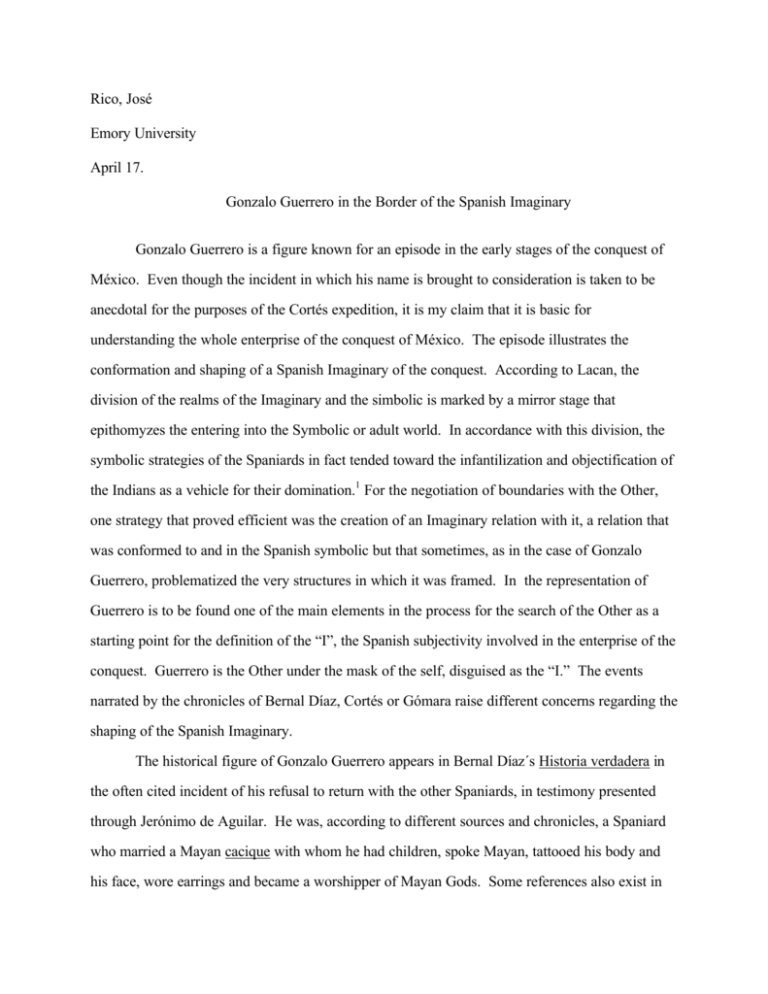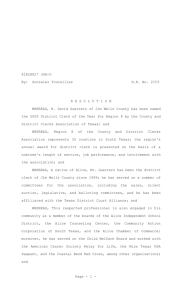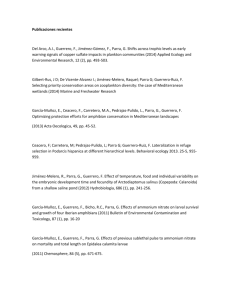Rico, José Emory University April 17. Gonzalo Guerrero in the
advertisement

Rico, José Emory University April 17. Gonzalo Guerrero in the Border of the Spanish Imaginary Gonzalo Guerrero is a figure known for an episode in the early stages of the conquest of México. Even though the incident in which his name is brought to consideration is taken to be anecdotal for the purposes of the Cortés expedition, it is my claim that it is basic for understanding the whole enterprise of the conquest of México. The episode illustrates the conformation and shaping of a Spanish Imaginary of the conquest. According to Lacan, the division of the realms of the Imaginary and the simbolic is marked by a mirror stage that epithomyzes the entering into the Symbolic or adult world. In accordance with this division, the symbolic strategies of the Spaniards in fact tended toward the infantilization and objectification of the Indians as a vehicle for their domination.1 For the negotiation of boundaries with the Other, one strategy that proved efficient was the creation of an Imaginary relation with it, a relation that was conformed to and in the Spanish symbolic but that sometimes, as in the case of Gonzalo Guerrero, problematized the very structures in which it was framed. In the representation of Guerrero is to be found one of the main elements in the process for the search of the Other as a starting point for the definition of the “I”, the Spanish subjectivity involved in the enterprise of the conquest. Guerrero is the Other under the mask of the self, disguised as the “I.” The events narrated by the chronicles of Bernal Díaz, Cortés or Gómara raise different concerns regarding the shaping of the Spanish Imaginary. The historical figure of Gonzalo Guerrero appears in Bernal Díaz´s Historia verdadera in the often cited incident of his refusal to return with the other Spaniards, in testimony presented through Jerónimo de Aguilar. He was, according to different sources and chronicles, a Spaniard who married a Mayan cacique with whom he had children, spoke Mayan, tattooed his body and his face, wore earrings and became a worshipper of Mayan Gods. Some references also exist in Rico/2 Oviedo’s Historia general, that are based on the oral account of a Spanish adventurer named Alonso Luján, who was an eyewitness to the adelantado Francisco de Montejo´s first encounter with the Mayas. Gonzalo Guerrero is there portrayed as Nacom, the organizer of indigenous resistance against the Spaniards.2 A comparison between the different versions of the episode of Jerónimo de Aguilar can give a more precise rendering of the formation of the Spanish Imaginary. A succinct narration of the episode is found in López de Gómara, where the reasons given for Guerrero’s staying with the Indians are given: Creo que de vergüenza, por tener horadada la nariz, picadas las orejas, pintado el rostro y manos a estilo de aquella tierra y gente, o por vicio de la mujer y cariño de los hijos.” Gran temor y admiración puso en los oyentes este cuento de Jerónimo de Aguilar, con decir que en aquella tierra comían y sacrificaban hombres, y por la desventura que él y sus compañeros habían pasado; pero daban gracias a Dios por verle libre de gente tan inhumana y bárbara, y por tenerlo por faraute cierto y verdadero. (Gómara 1986:59) Jerónimo de Aguilar was a friar who also survived the shipwreck and lived with Guerrero under the same Mayan rule, and who decided to accept the offer made by Cortés, in need of lenguas (interpreters) at the time of starting his enterprise in México. Some of the reasons that led to the creation of Gonzalo Guerrero as a figure through which Spaniards and Indians wrote their narratives can be found in the interaction between the interests of Aguilar and Cortés. In the physical and mental space of the border, a negotiation was taking place between the de-limitation of such borders not only in the physical sense through confrontation and warfare between Indians and Spaniards, but at the mental level as well. These conflicts between the Imaginary and the Symbolic, the realms of rationality and imagination, are most evident at the borders, on the limits of the unknown. Borders are the territory that question established values. 'La frontera' produces 'monstruos' such as Guerrero that become a nightmare for conquerors; it is also the site for Rico/3 selection and exclusion by means of the binary logic of what Derrida repeatedly calls 'logocentrism'. The enterprise of conquest needed to justify itself. The expedition in Yucatan was the launching of the first great military expedition by the Spaniards. The episode of Guerrero is a symptom of this anxiety for defining the limits and the reasons for the “signifying space” of the conquest. The imposition of a logos with clear limits was basic for a mechanism of exclusion and inclusion to take place, allowing the “reading” and framing of the Other under the schema of the conquest. A consideration of the specific circumstances of the encounter with Guerrero is important to understand its significance. Yucatán was a peripheral zone, not part of the Aztec Empire, with an uneven orography, no large natural ports, and a disseminated structure of power based on tribal organizations. For these reasons, it was marginal to the interest of Cortés, who was looking to maximize his military effort in order to justify his own disobedience to the Governor of Cuba, as his Relaciones well assert. Hence, what takes place in Yucatán is a trial run of the actual process of the Conquest. The narrative powers shown by Aguilar and his skills as interpreter will prove essential to Cortés in the Conquest of the Aztec Empire. This negotiation between the “I” of the Spaniards and the Other is paramount to the search for the right enemy, and for compelling reasons to fight. The Spaniards were more prepared for a classic battle in open field where the armies could measure their forces. That scenario was not possible in Yucatán due to the mountainous character of the region. Moreover, the Mayan area did not have a strong army but separate groups of warriors. Also, as a matter of principle the conquered land is that of the Other, which is of the utmost importance to delimit and separate the Other from the We. In that sense the metaphor of aggression and penetration used in warfare is intrinsic to the military “exploit”. The violation of the enemy´s land needs a virginal state, an unconquered metaphor that can trigger the aggression and the hope for the loot. In this Rico/4 case, the fact that Spaniards were already inhabiting this land created the need to narrativize in order to be able to mobilize these metaphors of conquest. Until the moment that Aguilar was re-covered, Cortés did not give up on his effort to get to hear the side of the story suitable to his own plans. For Cortés the conqueror the relevance of this episode did not pass inadverted, and it is worth pointing to the start of his “Primera relación,” where he discusses the inaccuracy of calling the new discovered lands Cozumel or Yucatán “sin ser lo uno ni lo otro” and will propose on his “Segunda relación” the name of Nueva España(Cortés 1993:106). The importance of the nomination process for defining the space in which Spanish law and society will be imposed has been sufficiently asserted by Gonzalez Echeverría. This awareness in the conqueror about the value of the linguistic process as a tool for empowerment is worth pointing because it is in the episode of Aguilar in which Cortés first deploys his argument of the providential character of the conquest, which is basic for the purposes of justifying his actions with the king. Due to a sudden weather change, Cortés renounces to embark his troops in search of the Spaniards, when they see a canoa: Vimos cómo venía en ella uno de los españoles cativos que se llama Jerónimo de Aguilar, el cual nos contó la manera cómo se había perdido y el tiempo que había que estaba en aquel cabtiverio[...] Y túvose entre nosotros aquella contrariedad de tiempo que sucedió de improviso, como es verdad, por muy gran misterio, milagro de Dios. (Cortés 1993:124) The insistence in going for the Spaniards, in trying to “recover” them with the deployment of all due force, is symptomatic of the importance for Cortés of the clarification of the status and situation of the possible survivors of the shipwreck. There is an anxiety for the delimitation of a border against the Other; Cortés is willing to penetrate the space of the Mayans to recover the Spaniards thought to be “on the other side.” The providential divine intervention is a signal of the existence of this border and at the same time of God’s standing on the Spaniards´ side. The “virginal state” metaphor was no longer possible because of the former penetration of some Spaniards in the territory. The penetration in the virginal land of Yucatan had already been Rico/5 effected by some Spaniards: Gonzalo Guerrero and Aguilar. It is symptomatic that Gonzalo´s surname, Guerrero, identifies him as a warrior. The identification with the figure that is lost, the “I” that has become Other is expressed through this generic name, which could be assumed by each member of Cortés’ expedition as his own. The news about Guerrero is offered to the Spaniards through his comrade Aguilar. Regardless of the circumstances Aguilar's testimony is unbelievable. For example, when he appeared before Cortés, he was indistinguishable from the Indians: he wore Indian clothes, had his ears pierced and carried a paddle on his shoulder. He bowed before Cortés in an Indian greeting at the same time that he was said to be a Spaniard. He had been keeping a book of devotions, an 'Horas', as a proof that he was a good Christian, although his perception of devotional schedules was proven to be wrong and was blamed on his isolation among non-Christians. If Guerrero had accompanied Aguilar, he could have told a different story, not only about himself but about Aguilar. Martínez Marín expresses doubts about Aguilar´s testimony when he affirms that at most Aguilar just sent a message to Guerrero telling him to come back with him and left without waiting for the answer. (Martínez Marín 407) At this point, Guerrero was either dead, did not survive the shipwreck, or was just leading the same life that Aguilar did. In all these possible scenarios, Guerrero was a part of Aguilar's memory that he would like to have erased in his new found life as a conqueror's interpreter. Aguilar's rendering of Guerrero's feats exceeds passive communication when he creates a dialogue with Guerrero that probably did not take place: Hermano Aguilar, yo soy casado, tengo tres hijos, y tiénenme por cacique y capitán cuando hay guerras: íos vos con Dios; que yo tengo labrada la cara e horadadas las orejas; ¿Qué dirán de mi desque me vean esos españoles ir desta manera? E ya veis estos mis tres hijitos qué bonicos son. Por vida vuestra que me deis desas cuentas verdes que traéis, para ellos, y diré que mis hermanos me las envían de mi tierra. (Bernal Díaz 1989:64) Rico/6 As the text by Bernal Díaz shows, Aguilar took good care of affirming: a) His Christianity, versus the 'Idolatry' of Guerrero. b) His celibacy, versus the 'vicio' that Guerrero had with his wife. c) His constancy in his religious practice and his hope to return with the Spaniards in the face of Guerrero's integration in Mayan society. Conscious of his role as mediator, Aguilar emphasizes the sense of fratría in the repeated allusions to the fraternal relation of Guerrero with the Spaniards thanks to the common identification with the national project. But on the other hand, the final step in his strategy is affirming that he tried to convince Guerrero to come back with him until he was disrupted by Guerrero's wife. She told him to leave her husband in peace; under such circumstances he had to give up on his efforts. That a woman could interrupt men's conversation was something that, for Spaniards in the XVI century, had a denigrating effect on the woman, but more importantly on Guerrero himself. The manhood of Guerrero is at stake in these assertions; this presumably contradicts the generic manhood inscribed in his name. After noting that Guerrero was submitting to the authority of his wife, who is portrayed as a warriorlike figure, a type of Amazon, Aguilar did not proceed further on the account of the scene possibly because mistery was rhetorically more effective at this point. By creating doubts about Guerrero´s masculinity, Aguilar made him an alien to the men in Cortés’s expedition. Guerrero himself confirms the “improper” character of his new identity as the main deterrent to coming back. Not being a “proper” Spaniard is already inscribed in his dress code, as well as in his body. Choosing sides in his case has to do with the impossibility of cleaning up the “traces” of his “conversion.” According to Aguilar´s narration, Guerrero decides to stay as the Other, rather than come back, thereby setting the limits of the tolerable for the Spaniards. Aguilar was following a clear strategy to cover his actions while a “native.” Actually, he had been in the service of the 'cacique' of Taxmar, for civil and military duties (Martínez Marín 406). Furthermore, in the Mayan Chronicles it is intriguing that no record seems to be kept of Guerrero, but there is documentation of Aguilar, with a puzzling affirmation: Rico/7 De esta manera, nuestra tierra fue descubierta por el Jerónimo de Aguilar, que tenía su suegro en Ah Naum Ah Pot, de Cozumel, en el año 1517. (Portilla 89)3 Surely these sources have not been given much attention that far. Contrasted with the chronicle of Bernal Díaz, the latter shows its unreliability in this passage, because the parties involved are not all heard and, furthermore, there are some witnesses personally implicated in the events narrated. Guerrero becomes then an 'alter ego' for Aguilar, the part of him that he tried to conceal with his discourse. When returning to the realm of the Spanish Colonial symbolic, he represses the part of him that was not assimilable by the Spaniards of Cortés’ expedition.4 Cortés leaves from Yucatán both with Aguilar as his lengua and also with a more precise definition of the characteristics and limits of the Other and, consequently, of the “We.” A figure that is both symmetrical and inverted with respect to that of Aguilar is the Indian Melcharejo, who after having been on the service of Cortés escapes and informs the Indians about the military intentions of the Spaniards. Nevertheless, his fate is less fortunate since he is killed by the Mayans, who blamed him for their defeats. Informing and organizing the Indians is also ascribed to Guerrero according to Bernal Díaz, to the extent that Cortés would like to punish him for being a traitor. De-limitations such as these were being realized on both sides, in order to mark the limits and justifications for the aggression. Shortly afterwards, this demonization of Guerrero extends to another higher level. When confronted with unexpected resistance in Yucatán, the Spaniards blame it on Guerrero, not Mayan military prowess (Jones 1989:28). It is highly significant that only at the point when the Montejos' expeditions to subdue the Mayans succeed, do they find Guerrero dead. In fact, they are told by Mayans that a dead body is Guerrero’s, because the Spaniards can not distinguish his naked body from a Mayan's.5 (Martínez Marín 408) Guerrero then becomes part of the Imaginary of the conquest as the 'Amazons' did at another level: The space for the monstrous and the non-assimilable is also the site for the repressed. The Spaniards' worst fears are personified in Guerrero: that the Indians could fight Rico/8 them with their own methods, that the Other could become them and that the Other could identify with them. Consequently the erasure of the split that for ideological reasons kept them separate could collapse the whole Spanish division between the Imaginary and the Symbolic: The very differentiation that permitted them an entitlement to invade and possess foreign lands. 1 Todorov asserts clearly the deployment of symbolically successfull strategies as key for the Spanish conquest. 2 See Jones for a critical evaluation of the sources of Guerrero as part of the Maya Resistance against the Spaniards, specially pages 27-33. 3 Leon-Portilla in El reverso de la conquista and other modern editions of Mayan chonicles makes possible the tracing of some of the Mayan past. 4 For the different reactions toward the Other in the Conquest -- ranging from assimilation, identification, to indiference-- see Todorov (191). 5 Marín takes the information from Bishop Landa. Villa Roiz uses a letter fron Cereceda that he reprints in his appendix, and arrives at a more 'dignifying' conclusion concerning Guerrero's death. Rico/9 Bibliography Bernal Díaz del Castillo. Historia verdadera de la conquista de la Nueva España. Ed. Sáenz de Santamaría. Madrid: Alianza, 1989. Cortés, Hernán. Cartas de relación. Ed. Delgado Gómez. Madrid: Castalia, 1993. Derrida, Jacques. Margins of Philosophy. Trans. Alan Bass. Chicago: University of Chicago Press, 1982. Gonzalez Echevarría, R. “Colón, Carpentier y los orígenes de la ficción latinoamericana.” La Torre 2.7 (1988). 439-452. Jones, Grant D. Maya Resistance to Spanish Rule. Albuquerque: University of New Mexico Press, 1989. Martínez Marín, Carlos. "La aculturación Indoespañola en la época del descubrimiento de México". Homenaje a Pablo Martínez del Río. México, D.F.: INAH, 1961. Lacan, Jacques. Ecrits. Transl. A. Sheridan. New York: Norton, 1977. León Portilla, Miguel. El reverso de la conquista. México: J. Mortiz, 1990. López de Gómara, Francisco. La conquista de México. Ed. J.L. de Rojas. Madrid: Historia 16, 1987. Todorov, Tzvetan. La conquéte de L’Amérique. La question de l'autre. Paris: Seuil, 1982. Villa Roiz, Carlos. Gonzalo Guerrero. Memoria olvidada. Trauma de México. México, D.F.: Plaza y Valdés, 1995.







